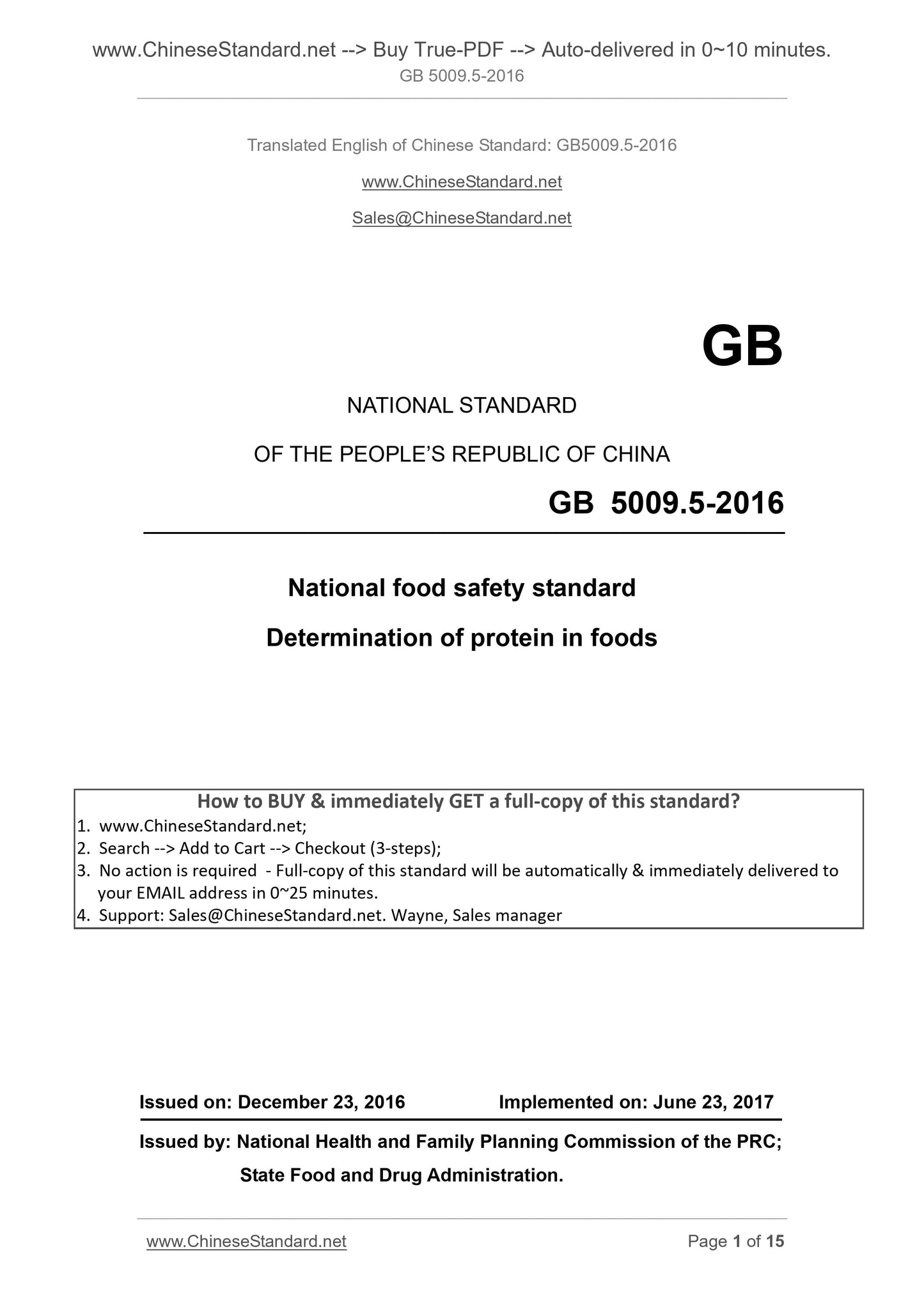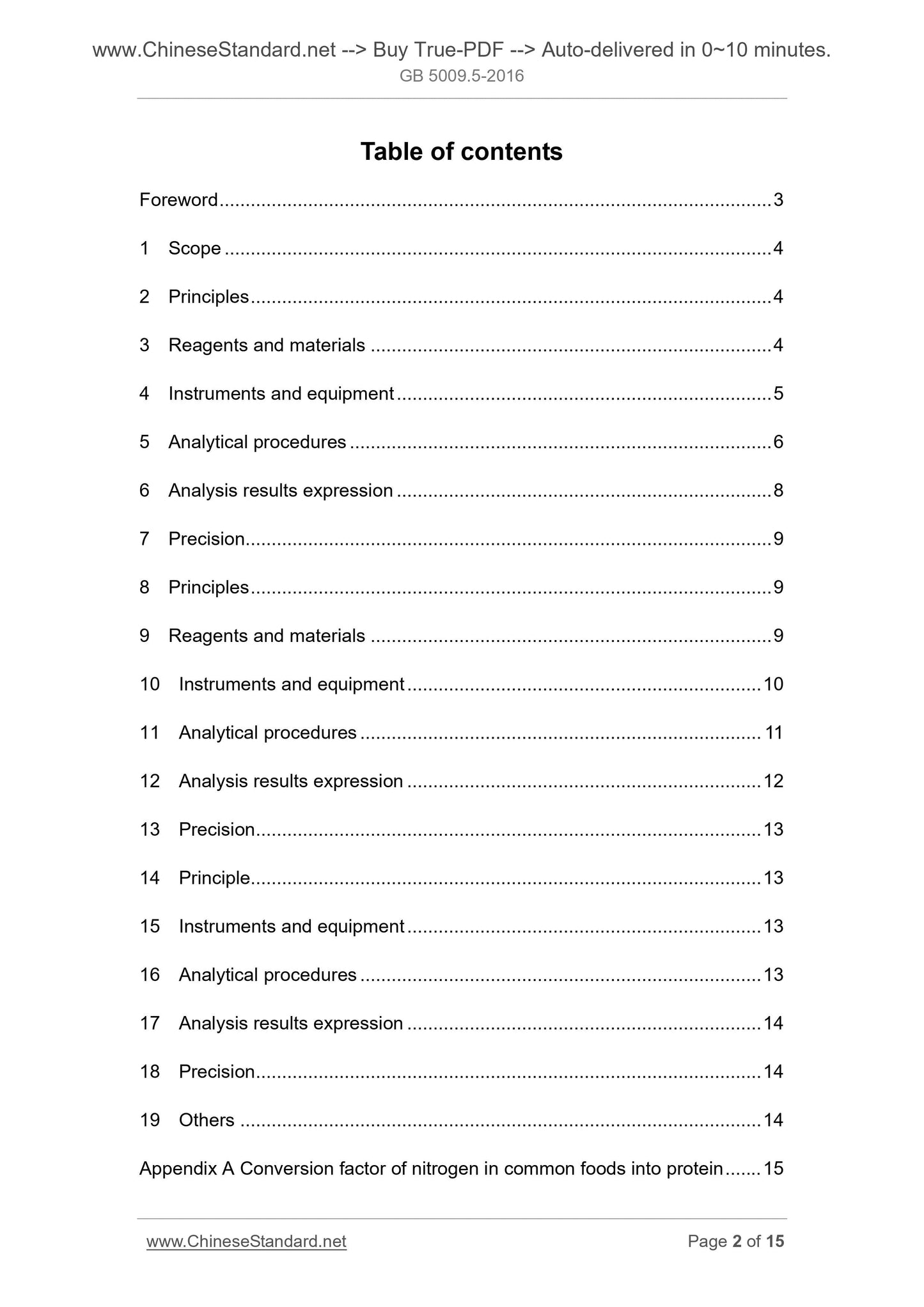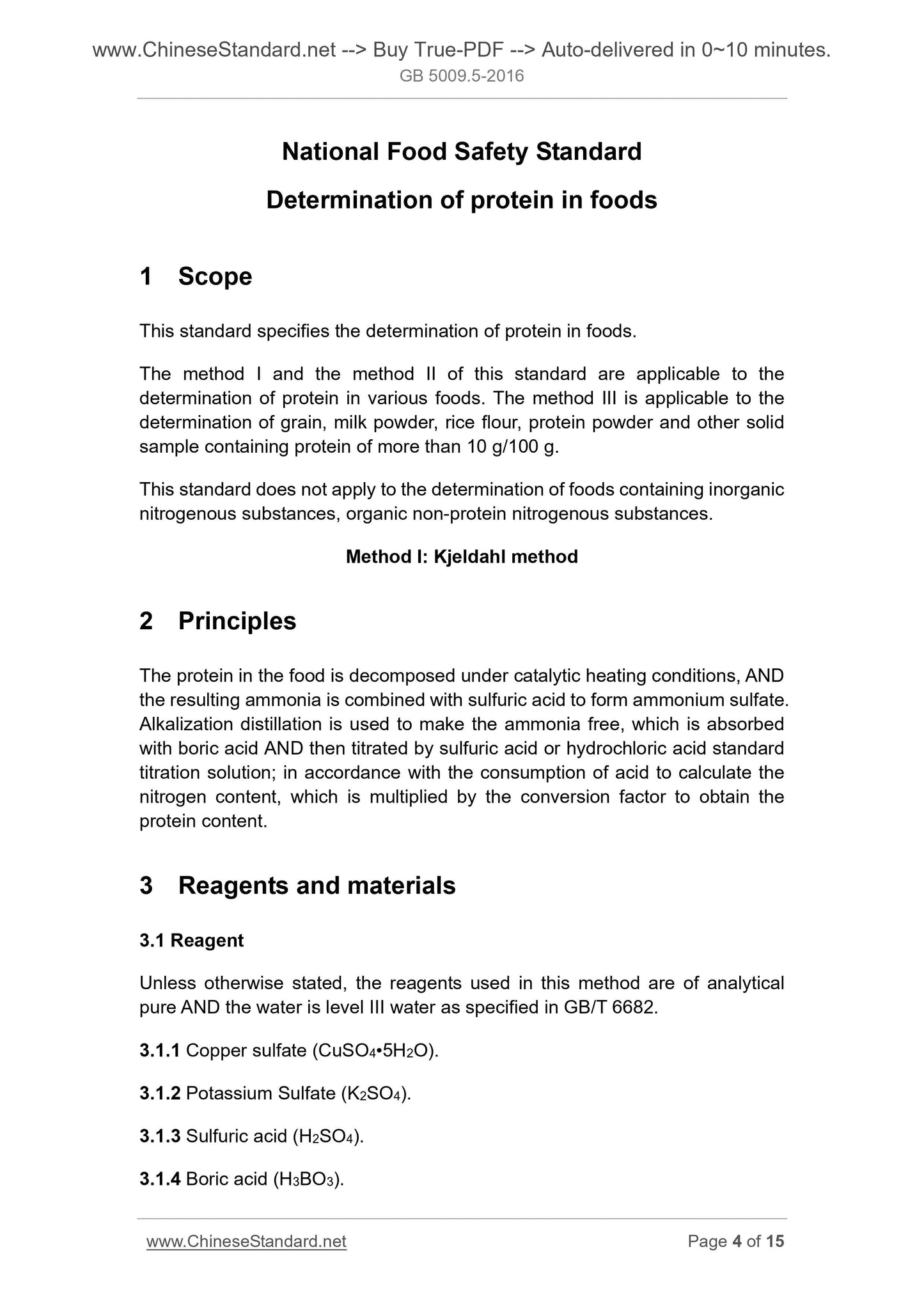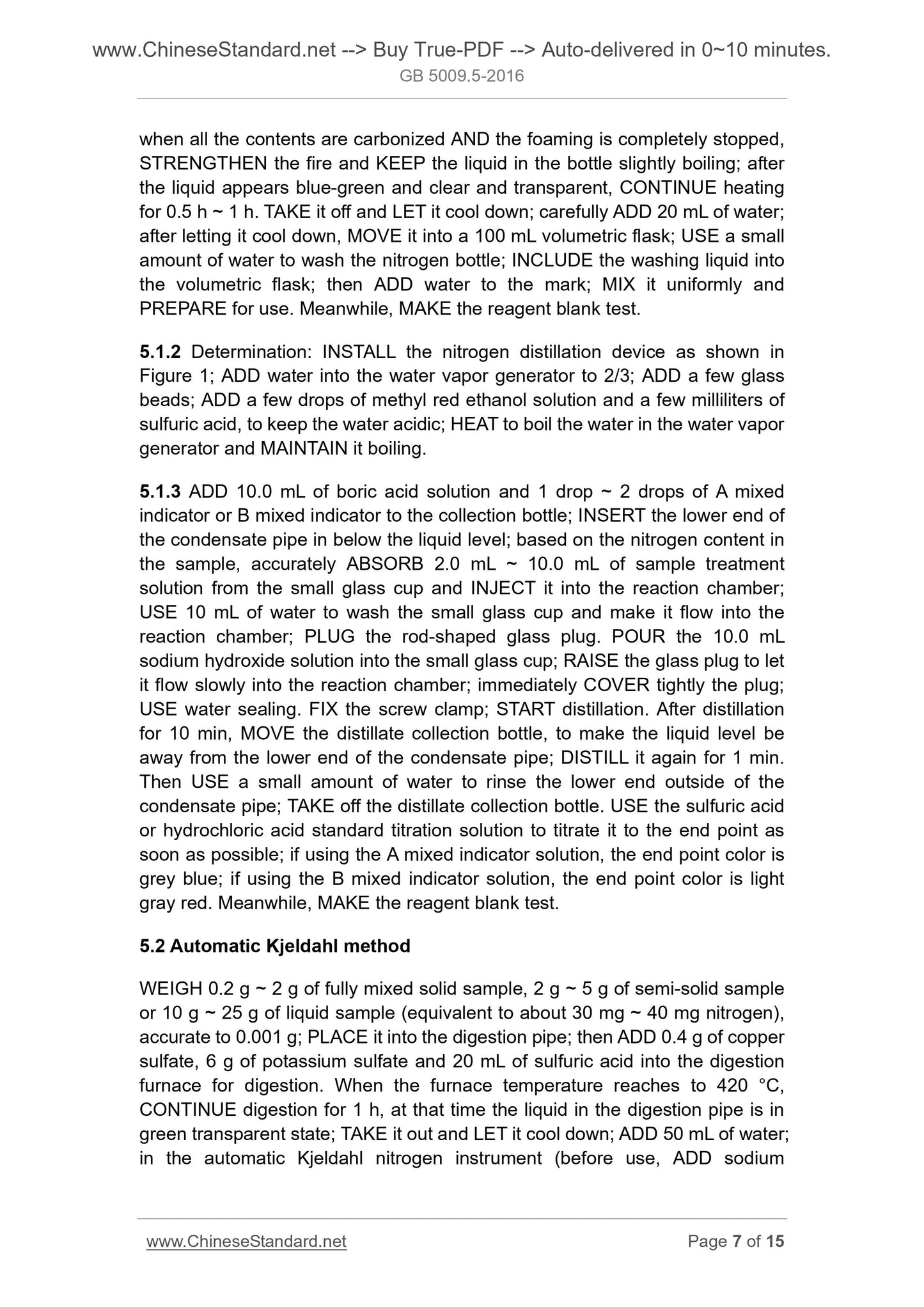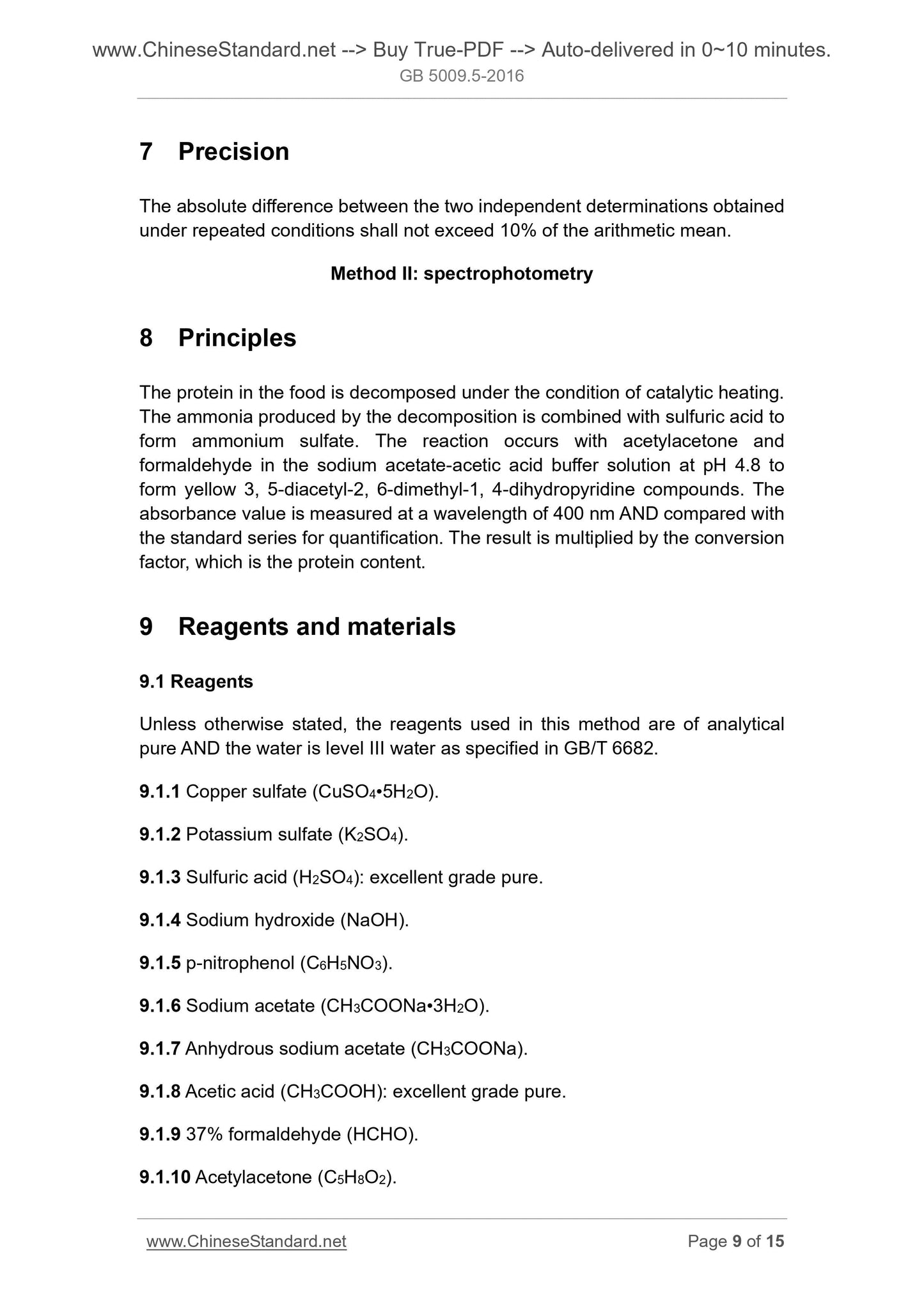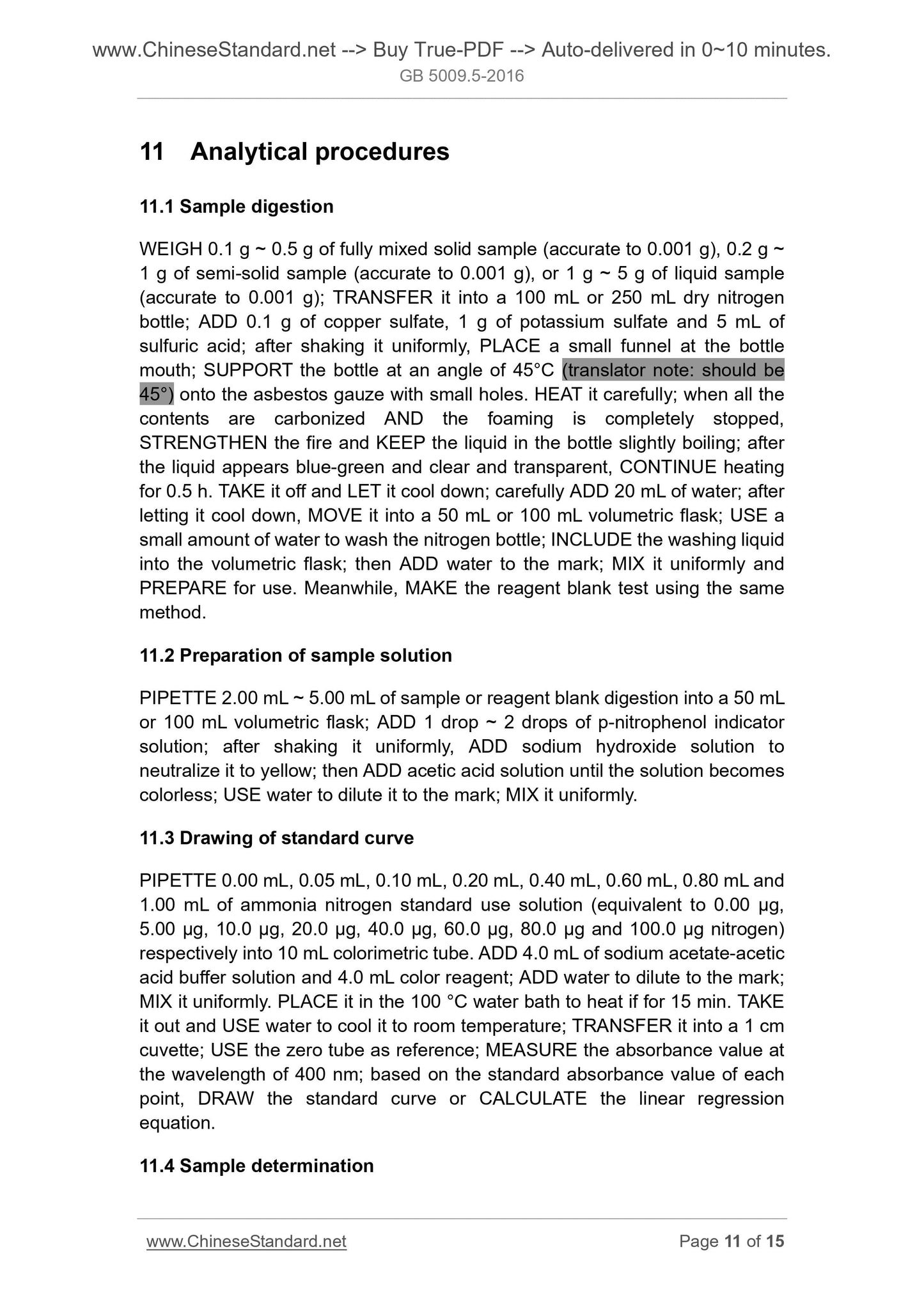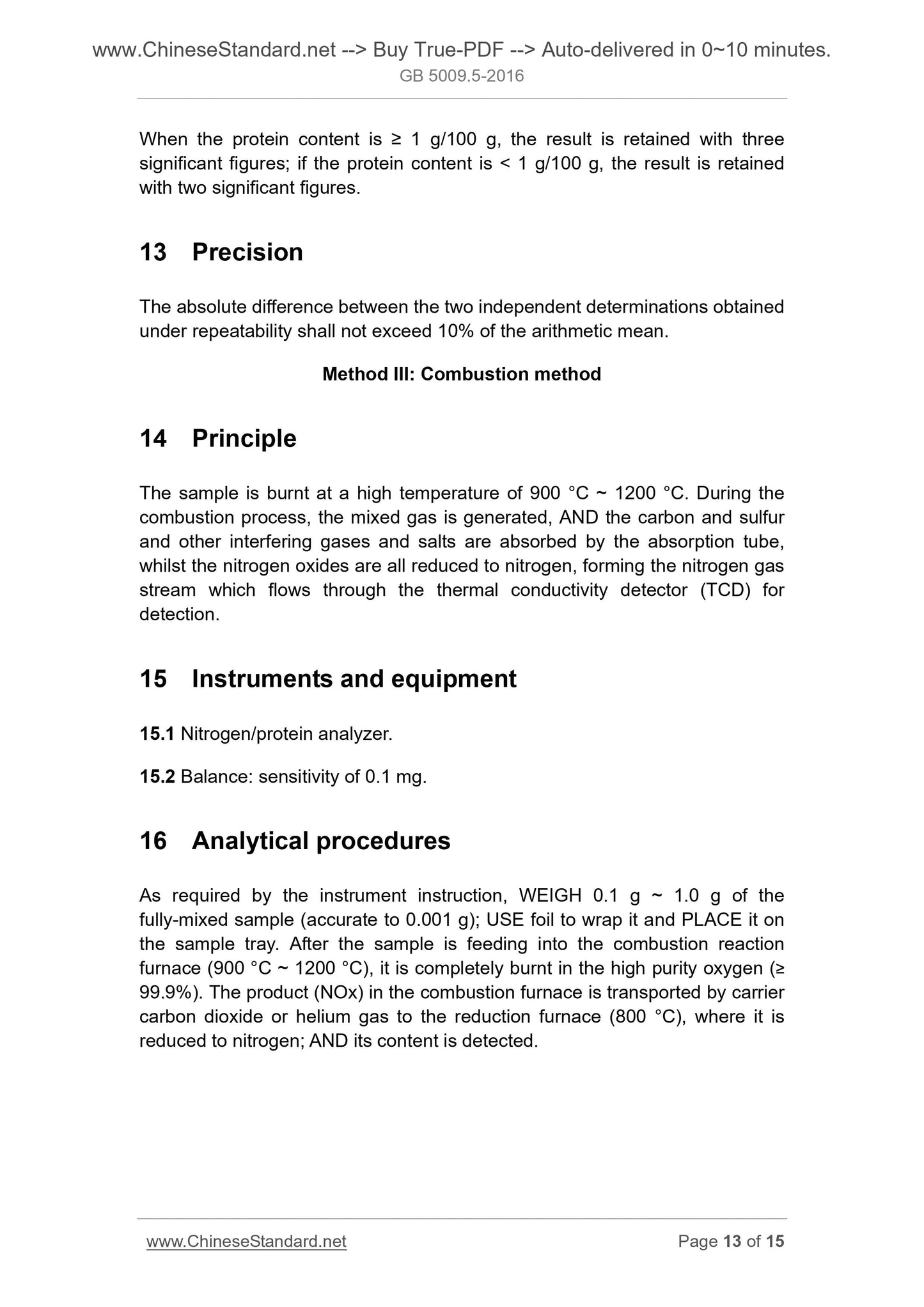1
/
of
7
www.ChineseStandard.us -- Field Test Asia Pte. Ltd.
GB 5009.5-2016 English PDF
GB 5009.5-2016 English PDF
Regular price
$85.00
Regular price
Sale price
$85.00
Unit price
/
per
Shipping calculated at checkout.
Couldn't load pickup availability
GB 5009.5-2016: National food safety standard - Determination of protein in foods
Delivery: 9 seconds. Download (& Email) true-PDF + Invoice.
Get Quotation: Click GB 5009.5-2016 (Self-service in 1-minute)
Historical versions (Master-website): GB 5009.5-2016
Preview True-PDF (Reload/Scroll-down if blank)
GB 5009.5-2016
GB
NATIONAL STANDARD
OF THE PEOPLE’S REPUBLIC OF CHINA
National food safety standard
Determination of protein in foods
ISSUED ON. DECEMBER 23, 2016
IMPLEMENTED ON. JUNE 23, 2017
Issued by. National Health and Family Planning Commission of the PRC;
State Food and Drug Administration.
Table of contents
Foreword ... 3
1 Scope ... 4
2 Principles ... 4
3 Reagents and materials ... 4
4 Instruments and equipment ... 5
5 Analytical procedures ... 6
6 Analysis results expression ... 8
7 Precision... 9
8 Principles ... 9
9 Reagents and materials ... 9
10 Instruments and equipment ... 10
11 Analytical procedures ... 11
12 Analysis results expression ... 12
13 Precision ... 13
14 Principle... 13
15 Instruments and equipment ... 13
16 Analytical procedures ... 13
17 Analysis results expression ... 14
18 Precision ... 14
19 Others ... 14
Appendix A Conversion factor of nitrogen in common foods into protein ... 15
National Food Safety Standard
Determination of protein in foods
1 Scope
This standard specifies the determination of protein in foods.
The method I and the method II of this standard are applicable to the
determination of protein in various foods. The method III is applicable to the
determination of grain, milk powder, rice flour, protein powder and other solid
sample containing protein of more than 10 g/100 g.
This standard does not apply to the determination of foods containing inorganic
nitrogenous substances, organic non-protein nitrogenous substances.
Method I. Kjeldahl method
2 Principles
The protein in the food is decomposed under catalytic heating conditions, AND
the resulting ammonia is combined with sulfuric acid to form ammonium sulfate.
Alkalization distillation is used to make the ammonia free, which is absorbed
with boric acid AND then titrated by sulfuric acid or hydrochloric acid standard
titration solution; in accordance with the consumption of acid to calculate the
nitrogen content, which is multiplied by the conversion factor to obtain the
protein content.
3 Reagents and materials
3.1 Reagent
Unless otherwise stated, the reagents used in this method are of analytical
pure AND the water is level III water as specified in GB/T 6682.
3.1.1 Copper sulfate (CuSO4•5H2O).
3.1.2 Potassium Sulfate (K2SO4).
3.1.3 Sulfuric acid (H2SO4).
3.1.4 Boric acid (H3BO3).
when all the contents are carbonized AND the foaming is completely stopped,
STRENGTHEN the fire and KEEP the liquid in the bottle slightly boiling; after
the liquid appears blue-green and clear and transparent, CONTINUE heating
for 0.5 h ~ 1 h. TAKE it off and LET it cool down; carefully ADD 20 mL of water;
after letting it cool down, MOVE it into a 100 mL volumetric flask; USE a small
amount of water to wash the nitrogen bottle; INCLUDE the washing liquid into
the volumetric flask; then ADD water to the mark; MIX it uniformly and
PREPARE for use. Meanwhile, MAKE the reagent blank test.
5.1.2 Determination. INSTALL the nitrogen distillation device as shown in
Figure 1; ADD water into the water vapor generator to 2/3; ADD a few glass
beads; ADD a few drops of methyl red ethanol solution and a few milliliters of
sulfuric acid, to keep the water acidic; HEAT to boil the water in the water vapor
generator and MAINTAIN it boiling.
5.1.3 ADD 10.0 mL of boric acid solution and 1 drop ~ 2 drops of A mixed
indicator or B mixed indicator to the collection bottle; INSERT the lower end of
the condensate pipe in below the liquid level; based on the nitrogen content in
the sample, accurately ABSORB 2.0 mL ~ 10.0 mL of sample treatment
solution from the small glass cup and INJECT it into the reaction chamber;
USE 10 mL of water to wash the small glass cup and make it flow into the
reaction chamber; PLUG the rod-shaped glass plug. POUR the 10.0 mL
sodium hydroxide solution into the small glass cup; RAISE the glass plug to let
it flow slowly into the reaction chamber; immediately COVER tightly the plug;
USE water sealing. FIX the screw clamp; START distillation. After distillation
for 10 min, MOVE the distillate collection bottle, to make the liquid level be
away from the lower end of the condensate pipe; DISTILL it again for 1 min.
Then USE a small amount of water to rinse the lower end outside of the
condensate pipe; TAKE off the distillate collection bottle. USE the sulfuric acid
or hydrochloric acid standard titration solution to titrate it to the end point as
soon as possible; if using the A mixed indicator solution, the end point color is
grey blue; if using the B mixed indicator solution, the end point color is light
gray red. Meanwhile, MAKE the reagent blank test.
5.2 Automatic Kjeldahl method
WEIGH 0.2 g ~ 2 g of fully mixed solid sample, 2 g ~ 5 g of semi-solid sample
or 10 g ~ 25 g of liquid sample (equivalent to about 30 mg ~ 40 mg nitrogen),
accurate to 0.001 g; PLACE it into the digestion pipe; then ADD 0.4 g of copper
sulfate, 6 g of potassium sulfate and 20 mL of sulfuric acid into the digestion
furnace for digestion. When the furnace temperature reaches to 420 °C,
CONTINUE digestion for 1 h, at that time the liquid in the digestion pipe is in
green transparent state; TAKE it out and LET it cool down; ADD 50 mL of water;
in the automatic Kjeldahl nitrogen instrument (before use, ADD sodium
7 Precision
The absolute difference between the two independent determinations obtained
under repeated conditions shall not exceed 10% of the arithmetic mean.
Method II. spectrophotometry
8 Principles
The protein in the food is decomposed under the condition of catalytic heating.
The ammonia produced by the decomposition is combined with sulfuric acid to
form ammonium sulfate. The reaction occurs with acetylacetone and
formaldehyde in the sodium acetate-acetic acid buffer solution at pH 4.8 to
form yellow 3, 5-diacetyl-2, 6-dimethyl-1, 4-dihydropyridine compounds. The
absorbance value is measured at a wavelength of 400 nm AND compared with
the standard series for quantification. The result is multiplied by the conversion
factor, which is the protein content.
9 Reagents and materials
9.1 Reagents
Unless otherwise stated, the reagents used in this method are of analytical
pure AND the water is level III water as specified in GB/T 6682.
9.1.1 Copper sulfate (CuSO4•5H2O).
9.1.2 Potassium sulfate (K2SO4).
9.1.3 Sulfuric acid (H2SO4). excellent grade pure.
9.1.4 Sodium hydroxide (NaOH).
9.1.5 p-nitrophenol (C6H5NO3).
9.1.6 Sodium acetate (CH3COONa•3H2O).
9.1.7 Anhydrous sodium acetate (CH3COONa).
9.1.8 Acetic acid (CH3COOH). excellent grade pure.
9.1.9 37% formaldehyde (HCHO).
9.1.10 Acetylacetone (C5H8O2).
11 Analytical procedures
11.1 Sample digestion
WEIGH 0.1 g ~ 0.5 g of fully mixed solid sample (accurate to 0.001 g), 0.2 g ~
1 g of semi-solid sample (accurate to 0.001 g), or 1 g ~ 5 g of liquid sample
(accurate to 0.001 g); TRANSFER it into a 100 mL or 250 mL dry nitrogen
bottle; ADD 0.1 g of copper sulfate, 1 g of potassium sulfate and 5 mL of
sulfuric acid; after shaking it uniformly, PLACE a small funnel at the bottle
mouth; SUPPORT the bottle at an angle of 45°C (translator note. should be
45°) onto the asbestos gauze with small holes. HEAT it carefully; when all the
contents are carbonized AND the foaming is completely stopped,
STRENGTHEN the fire and KEEP the liquid in the bottle slightly boiling; after
the liquid appears blue-green and clear and transparent, CONTINUE heating
for 0.5 h. TAKE it off and LET it cool down; carefully ADD 20 mL of water; after
letting it cool down, MOVE it into a 50 mL or 100 mL volumetric flask; USE a
small amount of water to wash the nitrogen bottle; INCLUDE the washing liquid
into the volumetric flask; then ADD water to the mark; MIX it uniformly and
PREPARE for use. Meanwhile, MAKE the reagent blank test using the same
method.
11.2 Preparation of sample solution
PIPETTE 2.00 mL ~ 5.00 mL of sample or reagent blank digestion into a 50 mL
or 100 mL volumetric flask; ADD 1 drop ~ 2 drops of p-nitrophenol indicator
solution; after shaking it uniformly, ADD sodium hydroxide solut...
GB 5009.5-2016
GB
NATIONAL STANDARD
OF THE PEOPLE’S REPUBLIC OF CHINA
National food safety standard
Determination of protein in foods
ISSUED ON. DECEMBER 23, 2016
IMPLEMENTED ON. JUNE 23, 2017
Issued by. National Health and Family Planning Commission of the PRC;
State Food and Drug Administration.
Table of contents
Foreword ... 3
1 Scope ... 4
2 Principles ... 4
3 Reagents and materials ... 4
4 Instruments and equipment ... 5
5 Analytical procedures ... 6
6 Analysis results expression ... 8
7 Precision... 9
8 Principles ... 9
9 Reagents and materials ... 9
10 Instruments and equipment ... 10
11 Analytical procedures ... 11
12 Analysis results expression ... 12
13 Precision ... 13
14 Principle... 13
15 Instruments and equipment ... 13
16 Analytical procedures ... 13
17 Analysis results expression ... 14
18 Precision ... 14
19 Others ... 14
Appendix A Conversion factor of nitrogen in common foods into protein ... 15
National Food Safety Standard
Determination of protein in foods
1 Scope
This standard specifies the determination of protein in foods.
The method I and the method II of this standard are applicable to the
determination of protein in various foods. The method III is applicable to the
determination of grain, milk powder, rice flour, protein powder and other solid
sample containing protein of more than 10 g/100 g.
This standard does not apply to the determination of foods containing inorganic
nitrogenous substances, organic non-protein nitrogenous substances.
Method I. Kjeldahl method
2 Principles
The protein in the food is decomposed under catalytic heating conditions, AND
the resulting ammonia is combined with sulfuric acid to form ammonium sulfate.
Alkalization distillation is used to make the ammonia free, which is absorbed
with boric acid AND then titrated by sulfuric acid or hydrochloric acid standard
titration solution; in accordance with the consumption of acid to calculate the
nitrogen content, which is multiplied by the conversion factor to obtain the
protein content.
3 Reagents and materials
3.1 Reagent
Unless otherwise stated, the reagents used in this method are of analytical
pure AND the water is level III water as specified in GB/T 6682.
3.1.1 Copper sulfate (CuSO4•5H2O).
3.1.2 Potassium Sulfate (K2SO4).
3.1.3 Sulfuric acid (H2SO4).
3.1.4 Boric acid (H3BO3).
when all the contents are carbonized AND the foaming is completely stopped,
STRENGTHEN the fire and KEEP the liquid in the bottle slightly boiling; after
the liquid appears blue-green and clear and transparent, CONTINUE heating
for 0.5 h ~ 1 h. TAKE it off and LET it cool down; carefully ADD 20 mL of water;
after letting it cool down, MOVE it into a 100 mL volumetric flask; USE a small
amount of water to wash the nitrogen bottle; INCLUDE the washing liquid into
the volumetric flask; then ADD water to the mark; MIX it uniformly and
PREPARE for use. Meanwhile, MAKE the reagent blank test.
5.1.2 Determination. INSTALL the nitrogen distillation device as shown in
Figure 1; ADD water into the water vapor generator to 2/3; ADD a few glass
beads; ADD a few drops of methyl red ethanol solution and a few milliliters of
sulfuric acid, to keep the water acidic; HEAT to boil the water in the water vapor
generator and MAINTAIN it boiling.
5.1.3 ADD 10.0 mL of boric acid solution and 1 drop ~ 2 drops of A mixed
indicator or B mixed indicator to the collection bottle; INSERT the lower end of
the condensate pipe in below the liquid level; based on the nitrogen content in
the sample, accurately ABSORB 2.0 mL ~ 10.0 mL of sample treatment
solution from the small glass cup and INJECT it into the reaction chamber;
USE 10 mL of water to wash the small glass cup and make it flow into the
reaction chamber; PLUG the rod-shaped glass plug. POUR the 10.0 mL
sodium hydroxide solution into the small glass cup; RAISE the glass plug to let
it flow slowly into the reaction chamber; immediately COVER tightly the plug;
USE water sealing. FIX the screw clamp; START distillation. After distillation
for 10 min, MOVE the distillate collection bottle, to make the liquid level be
away from the lower end of the condensate pipe; DISTILL it again for 1 min.
Then USE a small amount of water to rinse the lower end outside of the
condensate pipe; TAKE off the distillate collection bottle. USE the sulfuric acid
or hydrochloric acid standard titration solution to titrate it to the end point as
soon as possible; if using the A mixed indicator solution, the end point color is
grey blue; if using the B mixed indicator solution, the end point color is light
gray red. Meanwhile, MAKE the reagent blank test.
5.2 Automatic Kjeldahl method
WEIGH 0.2 g ~ 2 g of fully mixed solid sample, 2 g ~ 5 g of semi-solid sample
or 10 g ~ 25 g of liquid sample (equivalent to about 30 mg ~ 40 mg nitrogen),
accurate to 0.001 g; PLACE it into the digestion pipe; then ADD 0.4 g of copper
sulfate, 6 g of potassium sulfate and 20 mL of sulfuric acid into the digestion
furnace for digestion. When the furnace temperature reaches to 420 °C,
CONTINUE digestion for 1 h, at that time the liquid in the digestion pipe is in
green transparent state; TAKE it out and LET it cool down; ADD 50 mL of water;
in the automatic Kjeldahl nitrogen instrument (before use, ADD sodium
7 Precision
The absolute difference between the two independent determinations obtained
under repeated conditions shall not exceed 10% of the arithmetic mean.
Method II. spectrophotometry
8 Principles
The protein in the food is decomposed under the condition of catalytic heating.
The ammonia produced by the decomposition is combined with sulfuric acid to
form ammonium sulfate. The reaction o...
Delivery: 9 seconds. Download (& Email) true-PDF + Invoice.
Get Quotation: Click GB 5009.5-2016 (Self-service in 1-minute)
Historical versions (Master-website): GB 5009.5-2016
Preview True-PDF (Reload/Scroll-down if blank)
GB 5009.5-2016
GB
NATIONAL STANDARD
OF THE PEOPLE’S REPUBLIC OF CHINA
National food safety standard
Determination of protein in foods
ISSUED ON. DECEMBER 23, 2016
IMPLEMENTED ON. JUNE 23, 2017
Issued by. National Health and Family Planning Commission of the PRC;
State Food and Drug Administration.
Table of contents
Foreword ... 3
1 Scope ... 4
2 Principles ... 4
3 Reagents and materials ... 4
4 Instruments and equipment ... 5
5 Analytical procedures ... 6
6 Analysis results expression ... 8
7 Precision... 9
8 Principles ... 9
9 Reagents and materials ... 9
10 Instruments and equipment ... 10
11 Analytical procedures ... 11
12 Analysis results expression ... 12
13 Precision ... 13
14 Principle... 13
15 Instruments and equipment ... 13
16 Analytical procedures ... 13
17 Analysis results expression ... 14
18 Precision ... 14
19 Others ... 14
Appendix A Conversion factor of nitrogen in common foods into protein ... 15
National Food Safety Standard
Determination of protein in foods
1 Scope
This standard specifies the determination of protein in foods.
The method I and the method II of this standard are applicable to the
determination of protein in various foods. The method III is applicable to the
determination of grain, milk powder, rice flour, protein powder and other solid
sample containing protein of more than 10 g/100 g.
This standard does not apply to the determination of foods containing inorganic
nitrogenous substances, organic non-protein nitrogenous substances.
Method I. Kjeldahl method
2 Principles
The protein in the food is decomposed under catalytic heating conditions, AND
the resulting ammonia is combined with sulfuric acid to form ammonium sulfate.
Alkalization distillation is used to make the ammonia free, which is absorbed
with boric acid AND then titrated by sulfuric acid or hydrochloric acid standard
titration solution; in accordance with the consumption of acid to calculate the
nitrogen content, which is multiplied by the conversion factor to obtain the
protein content.
3 Reagents and materials
3.1 Reagent
Unless otherwise stated, the reagents used in this method are of analytical
pure AND the water is level III water as specified in GB/T 6682.
3.1.1 Copper sulfate (CuSO4•5H2O).
3.1.2 Potassium Sulfate (K2SO4).
3.1.3 Sulfuric acid (H2SO4).
3.1.4 Boric acid (H3BO3).
when all the contents are carbonized AND the foaming is completely stopped,
STRENGTHEN the fire and KEEP the liquid in the bottle slightly boiling; after
the liquid appears blue-green and clear and transparent, CONTINUE heating
for 0.5 h ~ 1 h. TAKE it off and LET it cool down; carefully ADD 20 mL of water;
after letting it cool down, MOVE it into a 100 mL volumetric flask; USE a small
amount of water to wash the nitrogen bottle; INCLUDE the washing liquid into
the volumetric flask; then ADD water to the mark; MIX it uniformly and
PREPARE for use. Meanwhile, MAKE the reagent blank test.
5.1.2 Determination. INSTALL the nitrogen distillation device as shown in
Figure 1; ADD water into the water vapor generator to 2/3; ADD a few glass
beads; ADD a few drops of methyl red ethanol solution and a few milliliters of
sulfuric acid, to keep the water acidic; HEAT to boil the water in the water vapor
generator and MAINTAIN it boiling.
5.1.3 ADD 10.0 mL of boric acid solution and 1 drop ~ 2 drops of A mixed
indicator or B mixed indicator to the collection bottle; INSERT the lower end of
the condensate pipe in below the liquid level; based on the nitrogen content in
the sample, accurately ABSORB 2.0 mL ~ 10.0 mL of sample treatment
solution from the small glass cup and INJECT it into the reaction chamber;
USE 10 mL of water to wash the small glass cup and make it flow into the
reaction chamber; PLUG the rod-shaped glass plug. POUR the 10.0 mL
sodium hydroxide solution into the small glass cup; RAISE the glass plug to let
it flow slowly into the reaction chamber; immediately COVER tightly the plug;
USE water sealing. FIX the screw clamp; START distillation. After distillation
for 10 min, MOVE the distillate collection bottle, to make the liquid level be
away from the lower end of the condensate pipe; DISTILL it again for 1 min.
Then USE a small amount of water to rinse the lower end outside of the
condensate pipe; TAKE off the distillate collection bottle. USE the sulfuric acid
or hydrochloric acid standard titration solution to titrate it to the end point as
soon as possible; if using the A mixed indicator solution, the end point color is
grey blue; if using the B mixed indicator solution, the end point color is light
gray red. Meanwhile, MAKE the reagent blank test.
5.2 Automatic Kjeldahl method
WEIGH 0.2 g ~ 2 g of fully mixed solid sample, 2 g ~ 5 g of semi-solid sample
or 10 g ~ 25 g of liquid sample (equivalent to about 30 mg ~ 40 mg nitrogen),
accurate to 0.001 g; PLACE it into the digestion pipe; then ADD 0.4 g of copper
sulfate, 6 g of potassium sulfate and 20 mL of sulfuric acid into the digestion
furnace for digestion. When the furnace temperature reaches to 420 °C,
CONTINUE digestion for 1 h, at that time the liquid in the digestion pipe is in
green transparent state; TAKE it out and LET it cool down; ADD 50 mL of water;
in the automatic Kjeldahl nitrogen instrument (before use, ADD sodium
7 Precision
The absolute difference between the two independent determinations obtained
under repeated conditions shall not exceed 10% of the arithmetic mean.
Method II. spectrophotometry
8 Principles
The protein in the food is decomposed under the condition of catalytic heating.
The ammonia produced by the decomposition is combined with sulfuric acid to
form ammonium sulfate. The reaction occurs with acetylacetone and
formaldehyde in the sodium acetate-acetic acid buffer solution at pH 4.8 to
form yellow 3, 5-diacetyl-2, 6-dimethyl-1, 4-dihydropyridine compounds. The
absorbance value is measured at a wavelength of 400 nm AND compared with
the standard series for quantification. The result is multiplied by the conversion
factor, which is the protein content.
9 Reagents and materials
9.1 Reagents
Unless otherwise stated, the reagents used in this method are of analytical
pure AND the water is level III water as specified in GB/T 6682.
9.1.1 Copper sulfate (CuSO4•5H2O).
9.1.2 Potassium sulfate (K2SO4).
9.1.3 Sulfuric acid (H2SO4). excellent grade pure.
9.1.4 Sodium hydroxide (NaOH).
9.1.5 p-nitrophenol (C6H5NO3).
9.1.6 Sodium acetate (CH3COONa•3H2O).
9.1.7 Anhydrous sodium acetate (CH3COONa).
9.1.8 Acetic acid (CH3COOH). excellent grade pure.
9.1.9 37% formaldehyde (HCHO).
9.1.10 Acetylacetone (C5H8O2).
11 Analytical procedures
11.1 Sample digestion
WEIGH 0.1 g ~ 0.5 g of fully mixed solid sample (accurate to 0.001 g), 0.2 g ~
1 g of semi-solid sample (accurate to 0.001 g), or 1 g ~ 5 g of liquid sample
(accurate to 0.001 g); TRANSFER it into a 100 mL or 250 mL dry nitrogen
bottle; ADD 0.1 g of copper sulfate, 1 g of potassium sulfate and 5 mL of
sulfuric acid; after shaking it uniformly, PLACE a small funnel at the bottle
mouth; SUPPORT the bottle at an angle of 45°C (translator note. should be
45°) onto the asbestos gauze with small holes. HEAT it carefully; when all the
contents are carbonized AND the foaming is completely stopped,
STRENGTHEN the fire and KEEP the liquid in the bottle slightly boiling; after
the liquid appears blue-green and clear and transparent, CONTINUE heating
for 0.5 h. TAKE it off and LET it cool down; carefully ADD 20 mL of water; after
letting it cool down, MOVE it into a 50 mL or 100 mL volumetric flask; USE a
small amount of water to wash the nitrogen bottle; INCLUDE the washing liquid
into the volumetric flask; then ADD water to the mark; MIX it uniformly and
PREPARE for use. Meanwhile, MAKE the reagent blank test using the same
method.
11.2 Preparation of sample solution
PIPETTE 2.00 mL ~ 5.00 mL of sample or reagent blank digestion into a 50 mL
or 100 mL volumetric flask; ADD 1 drop ~ 2 drops of p-nitrophenol indicator
solution; after shaking it uniformly, ADD sodium hydroxide solut...
GB 5009.5-2016
GB
NATIONAL STANDARD
OF THE PEOPLE’S REPUBLIC OF CHINA
National food safety standard
Determination of protein in foods
ISSUED ON. DECEMBER 23, 2016
IMPLEMENTED ON. JUNE 23, 2017
Issued by. National Health and Family Planning Commission of the PRC;
State Food and Drug Administration.
Table of contents
Foreword ... 3
1 Scope ... 4
2 Principles ... 4
3 Reagents and materials ... 4
4 Instruments and equipment ... 5
5 Analytical procedures ... 6
6 Analysis results expression ... 8
7 Precision... 9
8 Principles ... 9
9 Reagents and materials ... 9
10 Instruments and equipment ... 10
11 Analytical procedures ... 11
12 Analysis results expression ... 12
13 Precision ... 13
14 Principle... 13
15 Instruments and equipment ... 13
16 Analytical procedures ... 13
17 Analysis results expression ... 14
18 Precision ... 14
19 Others ... 14
Appendix A Conversion factor of nitrogen in common foods into protein ... 15
National Food Safety Standard
Determination of protein in foods
1 Scope
This standard specifies the determination of protein in foods.
The method I and the method II of this standard are applicable to the
determination of protein in various foods. The method III is applicable to the
determination of grain, milk powder, rice flour, protein powder and other solid
sample containing protein of more than 10 g/100 g.
This standard does not apply to the determination of foods containing inorganic
nitrogenous substances, organic non-protein nitrogenous substances.
Method I. Kjeldahl method
2 Principles
The protein in the food is decomposed under catalytic heating conditions, AND
the resulting ammonia is combined with sulfuric acid to form ammonium sulfate.
Alkalization distillation is used to make the ammonia free, which is absorbed
with boric acid AND then titrated by sulfuric acid or hydrochloric acid standard
titration solution; in accordance with the consumption of acid to calculate the
nitrogen content, which is multiplied by the conversion factor to obtain the
protein content.
3 Reagents and materials
3.1 Reagent
Unless otherwise stated, the reagents used in this method are of analytical
pure AND the water is level III water as specified in GB/T 6682.
3.1.1 Copper sulfate (CuSO4•5H2O).
3.1.2 Potassium Sulfate (K2SO4).
3.1.3 Sulfuric acid (H2SO4).
3.1.4 Boric acid (H3BO3).
when all the contents are carbonized AND the foaming is completely stopped,
STRENGTHEN the fire and KEEP the liquid in the bottle slightly boiling; after
the liquid appears blue-green and clear and transparent, CONTINUE heating
for 0.5 h ~ 1 h. TAKE it off and LET it cool down; carefully ADD 20 mL of water;
after letting it cool down, MOVE it into a 100 mL volumetric flask; USE a small
amount of water to wash the nitrogen bottle; INCLUDE the washing liquid into
the volumetric flask; then ADD water to the mark; MIX it uniformly and
PREPARE for use. Meanwhile, MAKE the reagent blank test.
5.1.2 Determination. INSTALL the nitrogen distillation device as shown in
Figure 1; ADD water into the water vapor generator to 2/3; ADD a few glass
beads; ADD a few drops of methyl red ethanol solution and a few milliliters of
sulfuric acid, to keep the water acidic; HEAT to boil the water in the water vapor
generator and MAINTAIN it boiling.
5.1.3 ADD 10.0 mL of boric acid solution and 1 drop ~ 2 drops of A mixed
indicator or B mixed indicator to the collection bottle; INSERT the lower end of
the condensate pipe in below the liquid level; based on the nitrogen content in
the sample, accurately ABSORB 2.0 mL ~ 10.0 mL of sample treatment
solution from the small glass cup and INJECT it into the reaction chamber;
USE 10 mL of water to wash the small glass cup and make it flow into the
reaction chamber; PLUG the rod-shaped glass plug. POUR the 10.0 mL
sodium hydroxide solution into the small glass cup; RAISE the glass plug to let
it flow slowly into the reaction chamber; immediately COVER tightly the plug;
USE water sealing. FIX the screw clamp; START distillation. After distillation
for 10 min, MOVE the distillate collection bottle, to make the liquid level be
away from the lower end of the condensate pipe; DISTILL it again for 1 min.
Then USE a small amount of water to rinse the lower end outside of the
condensate pipe; TAKE off the distillate collection bottle. USE the sulfuric acid
or hydrochloric acid standard titration solution to titrate it to the end point as
soon as possible; if using the A mixed indicator solution, the end point color is
grey blue; if using the B mixed indicator solution, the end point color is light
gray red. Meanwhile, MAKE the reagent blank test.
5.2 Automatic Kjeldahl method
WEIGH 0.2 g ~ 2 g of fully mixed solid sample, 2 g ~ 5 g of semi-solid sample
or 10 g ~ 25 g of liquid sample (equivalent to about 30 mg ~ 40 mg nitrogen),
accurate to 0.001 g; PLACE it into the digestion pipe; then ADD 0.4 g of copper
sulfate, 6 g of potassium sulfate and 20 mL of sulfuric acid into the digestion
furnace for digestion. When the furnace temperature reaches to 420 °C,
CONTINUE digestion for 1 h, at that time the liquid in the digestion pipe is in
green transparent state; TAKE it out and LET it cool down; ADD 50 mL of water;
in the automatic Kjeldahl nitrogen instrument (before use, ADD sodium
7 Precision
The absolute difference between the two independent determinations obtained
under repeated conditions shall not exceed 10% of the arithmetic mean.
Method II. spectrophotometry
8 Principles
The protein in the food is decomposed under the condition of catalytic heating.
The ammonia produced by the decomposition is combined with sulfuric acid to
form ammonium sulfate. The reaction o...
Share
